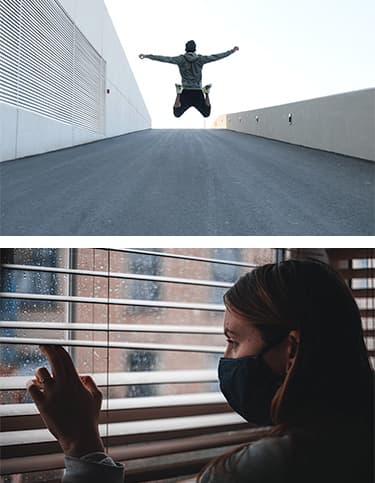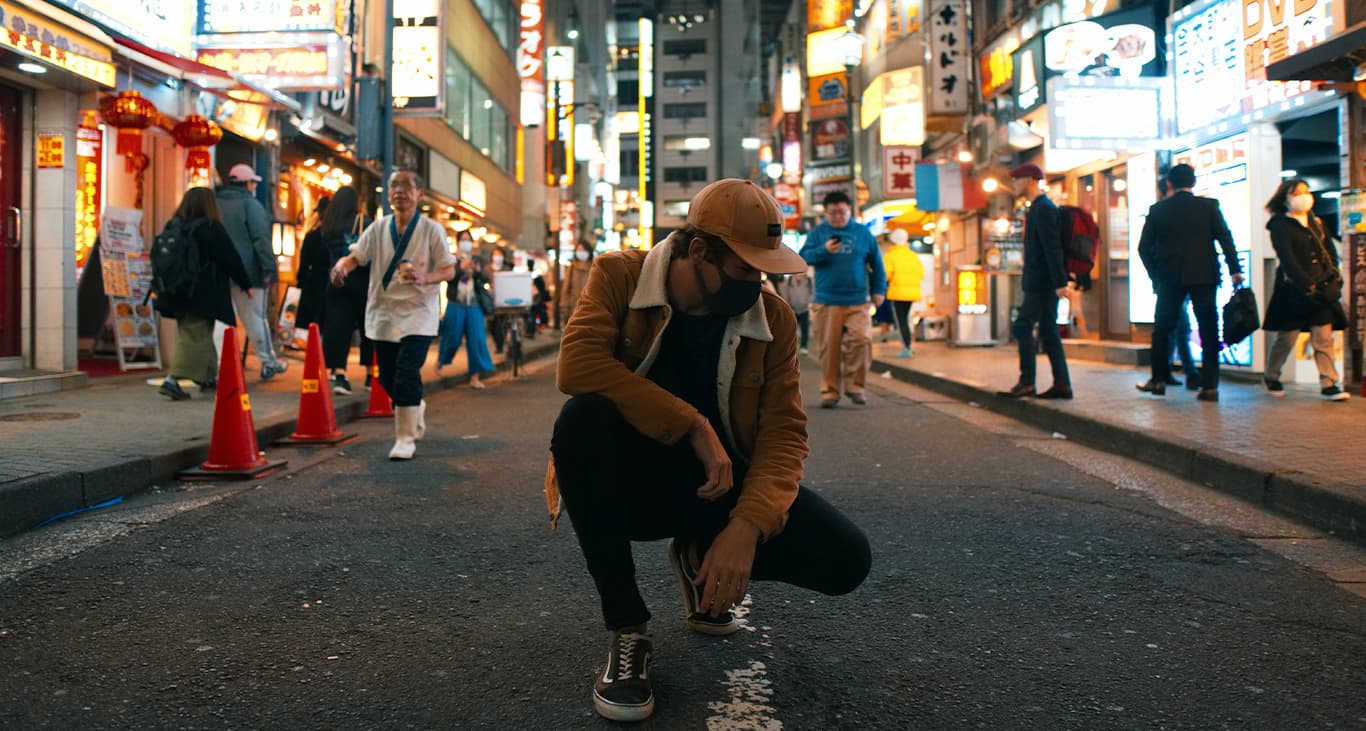5 Steps for Overcoming Social Anxiety After COVID Isolation
Reading Time: 6 minutesAs much as we all want to get back to “normal” life post-COVID, that doesn’t mean re-entry will be easy. After more than a year of social distancing and limited activities outside the home, many people are feeling anxious about what it will be like to spend more time with friends, in groups, and out in the world. In fact, an American Psychological Association poll taken in February 2021 found that half of American adults—even those who were vaccinated—were uneasy about returning to in-person interaction.
Young adults who have been living at home with parents, or socializing only with a small pod of close friends, may be experiencing social anxiety symptoms for the first time as they prepare to expand their IRL connections—yet another dimension of the pandemic’s impact on mental health. For those who suffered from social phobias before the pandemic, getting back out there may feel even scarier. However, there are some helpful steps for overcoming social anxiety that can make the process smoother and less frightening.
What Is Re-Entry Anxiety?
Also known as re-entry fear, cabin syndrome, snail syndrome (syndrome de l’escargot in French), and cave syndrome, re-entry anxiety refers to the discomfort created when we’re forced to leave the safe and comfortable environment we’ve created at home. Re-entry anxiety can be especially overwhelming when we’re not sure what we’ll encounter out in the world. The American psychologists John and Jeanne Gullahorn first explored this concept in the context of the “reverse culture shock” experienced when returning home from a foreign country after a long time away. Not only have you changed after experiencing new things, the place you’re returning to has also changed. Hence, there’s a period of readjustment before things feel familiar again.
Over the past year and more, we’ve become accustomed to living with the pandemic. In order to avoid decision fatigue, we’ve created boundaries regarding activities and social distancing, and stayed within them for the most part. Venturing outside those boundaries can feel strange and threatening. Therefore, having social anxiety symptoms related to re-entry is an expected and understandable response.
Know the Facts
49% of adults are experiencing re-entry anxiety.
Types of Social Anxiety Related to Re-Entry
Experts say there are three types of re-entry anxiety right now:
- Fear of catching and spreading the virus, even though vaccination greatly reduces this likelihood
- Feeling that one’s social skills have atrophied from lack of practice, and hence it will be awkward to spend time with others in person after adapting to virtual modes of connection
- Social anxiety that was diagnosed before the pandemic and is now being triggered by having to engage in more interaction again.
Moreover, certain segments of the population may experience more intense feelings of re-entry anxiety, including individuals from ethnic and racial groups who have been impacted disproportionately by the pandemic, people with existing mental health disorders, and those who suffered more acute trauma as a result of COVID, such as losing a loved one to the virus.


How Distancing Has Impacted Young Adult Social Skills
The pandemic’s impact on mental health has included dramatic increases in young adult depression, suicidal ideation, trauma, and anxiety. Now we’re seeing new cases of social anxiety and depression arising as a result of re-entry fears and pandemic-related PTSD. Young adult social skills are affected not only by the circumstances created by the pandemic, but also by the mental health disorders it has catalyzed. Research on past pandemics and epidemics show that people experience PTSD, OCD, and agoraphobia for as long as four years afterward.
However, some young people with social anxiety have experienced temporary relief from distressing social anxiety symptoms during social isolation and distancing, because they had permission to avoid triggering social situations. For them, it may be particularly challenging to return to a more normal level of social interaction. Therefore, their social anxiety symptoms may be especially intense at first.
Young adults with social anxiety, also called social phobia, experience intense dread about impending social situations, and an overwhelming fear of being judged or rejected once they are in those social settings. This often manifests as physical symptoms, such as a pounding heart, shortness of breath, feeling sweaty or dizzy, and tightness in the chest. Young adult social skills are impaired by social anxiety, meaning that they will often speak very quietly and avoid making eye contact.
Know the Facts
The majority of people with social anxiety disorder first experience symptoms before age 30.
Five Steps for Overcoming Social Anxiety
Mental health professionals recommend taking the following approaches for managing social anxiety and rebuilding young adult social skills.
1. Take it slow and steady.
Small, gradual steps toward re-entry will be more helpful in overcoming social anxiety than jumping into the deep end, experts say. Young adults can even create a plan and timeline for slowly increasing their level of social interaction over time. It’s best to start with a few people you trust rather than a group situation, and choose an activity that feels less anxiety-provoking, like a picnic or shopping, rather than eating at a restaurant, for example. Be sure to stay out of the house long enough that the anxiety begins to fade a bit, and you remember that social interaction out in the world can actually be fun and relaxing. The next time you venture out, push just a little bit farther outside your comfort zone—while still staying safe, of course. This approach is known as “exposure therapy,” and has been shown to be effective for social anxiety and other phobias.
2. Visualize a positive outcome, and plan for it.
One of the symptoms of social anxiety is imagining the worst thing possible happening in a social situation—being humiliated or embarrassed, saying something that people don’t like, or being the center of attention after making a faux pas of some kind. Hence, managing social anxiety involves shifting the way you think about future social scenarios. When negative thoughts and fears arise, practice reframing these patterns. Imagine the best possible outcome for a social situation, and make plans that increase the likelihood that things will go the way you envision them. For example, if you’re going to a group gathering with people you don’t know well, meet up with one good friend first and go together. Role-playing possible situations and conversations with a trusted friend or family beforehand can also help. In addition, remind yourself that others likely have similar anxieties, particularly right now; the pandemic’s impact on mental health has been particularly harsh for young adults. You are not alone in creating strategies for overcoming social anxiety.
3. Stay in the moment.
Another key to overcoming social anxiety is finding tools for focusing on the present moment, rather than worrying about the future or obsessing over something that happened in the past. Mindfulness-based therapy has been proven effective for social anxiety, and simple mindfulness practices can support young adults in managing social anxiety symptoms. One of the most powerful of these is mindful breathing—taking slow, deep breaths, with the exhale slightly longer than the inhale, when feelings of panic and fear arise. Another helpful mindfulness practice uses the senses: Rather than focusing on negative thoughts, tune in to the sensations you’re experiencing. Feel the sun on your skin, listen to the sounds surrounding you, notice the colors and light in your environment. These practices activate the relaxation response, reducing social anxiety symptoms and lowering the levels of cortisol (the stress hormone) being released in the body. Doing these practices on a regular basis, even for just a few minutes twice a day, allows the mind and body to more easily shift into the relaxation response during moments of intense distress.
4. Practice self-compassion.
Young adults with social anxiety tend to have more negative views of themselves, because of their heightened self-judgment. Therefore, it’s important for them to activate self-compassion, especially when managing social anxiety after isolation. Just as everyone has had different experiences, responses, and behaviors during the pandemic, everyone will have different reactions to re-entry. Beyond adhering to recommended safety guidelines, there is no “right” way to reengage socially. Young adults need to be kind to themselves, avoid comparing themselves to others, and be okay moving at their own pace rather than pushing themselves to do things they’re not ready for. While emerging from isolation is ultimately supportive for young adult social skills and mental health, as it becomes safe to do so, it does not have to happen all at once.
5. Talk to a therapist.
If overcoming social anxiety feels impossible without support, talking with a mental health professional is essential. Whether social anxiety symptoms are new, or are resurfacing with greater strength after the past year of isolation and distancing, treatment can help. Cognitive Behavioral Therapy incorporating exposure techniques is particularly effective for treating and managing social anxiety. CBT helps young adults reexamine their self-destructive thought patterns and practice being in situations that might trigger social anxiety symptoms. Researchers are even exploring the idea of using virtual-reality simulation for overcoming social anxiety.
Because social anxiety and depression often go hand in hand, treatment for social anxiety may include address the underlying causes of these related mental health disorders, as well as co-occurring disorders like substance abuse. Therefore, family therapy and trauma-focused modalities, such as EMDR, may be part of the treatment protocol, as young adults confront and heal childhood trauma and attachment wounds. Along with overcoming social anxiety, young adults will gain self-knowledge, practice healthy coping mechanisms for stress, and learn skills for forming the authentic connections that will support them in all aspects of life as they emerge into a post-pandemic world.
Contact us today to learn more about Newport Institute’s approach to healing young adult social anxiety and depression.

